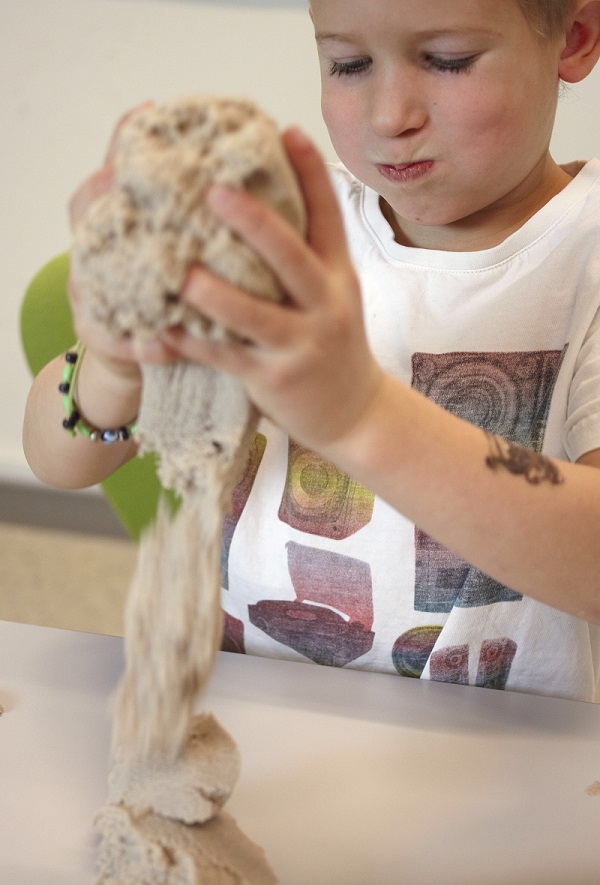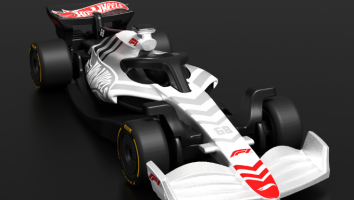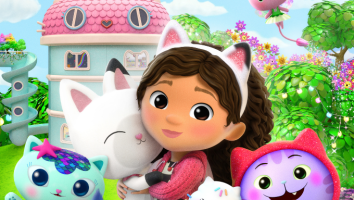Despite the freezing temps and fresh dumping of snow, it’s possible to compare New York Toy Fair held at Javits Convention Center in February to a walk on the beach. The reason is simple—there was a lot of sand on the show floor. While recent Toy Fairs have been marked by the proliferation of digital displays and touchscreen technology, the 2014 edition had a decidedly more earthy feel.
“It’s been very popular,” says Kathy Lorkovic, editor and merchandiser for Elkhorn, Nebraska-based distributor Fat Brain Toys. “We really noticed that sand play picked up steam right before the holidays last year.”
In fact, Lorkovic says Fat Brain, which distributes goods for more than 375 different toy manufacturers, including multiple lines of sand products, reported sales growth of roughly 70% in the sand category over last year.
While much ink has been spilled on the year-over-year growth of the construction category, led by Lego, perhaps the area of “organic construction” has been getting short shrift. Port Washington, New York-based retail watcher The NPD Group doesn’t specifically track toy sand, but it is included as a sub-category of Outdoor and Sports Toys that saw an increase of 1% to US$4.37 billion in 2013. The growth is notable in a year where most other categories shrank.
Sensory experience
“Kids need a break from the screen,” says Krista DiBerardino, CMO of Toronto, Canada-based toyco Spin Master. “That is why we are seeing some physical play patterns making a comeback.”
Moss Kardener, VP and Colorforms division manager for San Francisco, California-based University Games, agrees. He adds that the growth in sand products is a direct reaction to the glut of screens (TV, tablet and computer) in children’s play diets.
“Sand is a fully sensory experience and it sparks imagination,” he says. “From parents’ standpoints, they are becoming more sophisticated and they know that kids have to learn to relate to more than a two-dimensional screen.”
Sand play also facilitates free-form expression and helps build children’s creative and social capacities. Whether it’s learning to share the shovel in the sandbox, or performing their first science experiment by adding sand to water to create mud, kids’ love of playing in the dirt is universal and timeless.
“It accommodates all age groups, there are no instructions, and there are no performance expectations,” says Lorkovic. “A lot of products out there for kids now tend to be over-stimulating, which is why we find parents and kids are both attracted to the relaxing and stress-relieving aspects of sand.”
Licensed extensions
A good indication of the growing popularity of sand-based play is the recent emergence of licensed products in the category. This summer, for example, University Games is introducing its first line of branded My Little Sandbox kits, a product developed by San Mateo, California’s Be Good Company. “It’s really our first licensed sandbox,” notes Kardener.
The first line of My Little Sandbox licensed Nickelodeon products will feature Dora the Explorer, SpongeBob SquarePants, Bubble Guppies and Peter Rabbit-themed kits. Each includes a 10-inch x 10-inch x 2-inch colored sandbox, a 20-inch x 20-inch play mat and themed accessories, as well as ultra-fine sand, a grooming rake and a shovel. University Games will be distributing the kits through the specialty retail channel and online with a US$24.99 price tag.
While Kardener concedes that some of the appeal of sand play lays in its open-ended characteristics, he says the licensed products are meant to give a jump-start to the traditional play pattern. “It’s a starting point for creativity,” he says, adding that the new licensed line was a popular attraction at the University Games booth at Toy Fair.
“Kids are looking for something to start with—the licenses make that available to them,” says Kardener. “They can start with Dora or SpongeBob and then take it wherever they want.”
It’s sand—only better
Another driving factor in the sand category is the application of the popular and long-standing play pattern to a new compound that shares many properties with sand, but none of its traditional drawbacks. “Kinetic Sand is getting a lot of attention,” says Lorkovic.
Fat Brain distributes the product, in association with Broomfield, Colorado-based Waba Fun, to the specialty market. Lorkovic says word-of-mouth has made the product one of its bestselling items.
The new product is 98% real sand, but a non-toxic polymer (antimicrobial, wheat and gluten-free) binding agent makes up the other 2% to create a new compound with unique properties.
It was developed by Halmstad, Sweden-based manufacturers Delta of Sweden. Spin Master recently acquired the rights for wider distribution of the compound to mass-market channels and will be placing it at Toys ‘R’ Us locations, among other US mass retailers, starting in June.
“Kids tell us it’s like a cloud,” says Spin Master’s DiBerardino. “The kinetic aspect of it is you can put your hand in it and it behaves almost like flowable energy. You can squish it and sculpt it and it never dries out. There is no mess and no fuss.”
The compound will be sold in various packages and weights. A two-pound container will retail for US$14.99.
DiBerardino points out the compound demands special packaging to fully display its unique properties. And Spin Master is working with retailers to give consumers a chance to play with the product before they take it to the check-out line. “The marketing is heavily based on the experiential aspects,” she says. “There will be demos and a heavy presence on YouTube. It’s hard to explain exactly what it is unless you see it and play with it.”
Back to basics
While the new compound might offer a more clean-up-friendly experience, Noah McKiernan, brand manager of Little Tikes outdoor products, says it’s hard to beat the real thing. “It’s a play pattern that has been around forever and it’s not going anywhere,” he says.
The Hudson, Ohio-based subsidiary of MGA Entertainment has been producing outdoor sandboxes (sand not included) for more than three decades, and while other categories have come and gone out of vogue, McKiernan says that the sand-play business has been steady.
Innovation for the company comes in terms of adding new features to already well-established products.
“This year we have the Big Digger Sandbox,” he says. “It has a big excavator arm that attaches to the outside of the box. It makes it more like a construction site.” The set retails for US$49.99 at Toys ‘R’ Us and through Little Tikes own website and various online retailers.
The key to product development, McKiernan says, is to add to the classic play-pattern without detracting from all of the positive characteristics inherent in basic sand play. “Fresh air, sunshine, learning how to cooperate with other kids, building something for the first time, you just can’t beat that,” he says. “It’s never going to go away.”
This article originally appeared in the April 2014 issue of Kidscreen

























